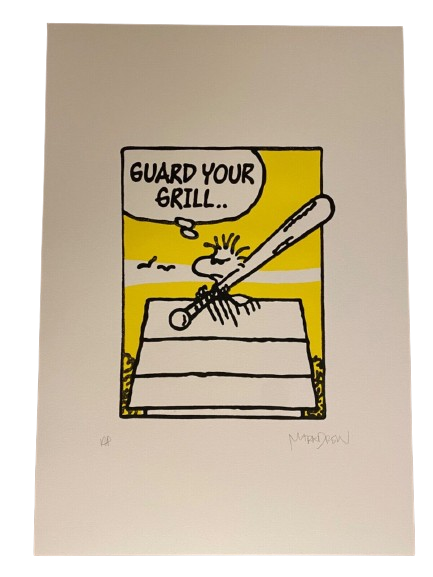
Text Type Words & Sayings

Mark Drew Guard Your Grill Naughty by Nature AP Silkscreen Print by Mark Drew
Guard Your Grill Naughty by Nature A.P. Silkscreen Print by Mark Drew Artist Proof Hand-Pulled Screen Print on Fine Art Paper Limited Edition Pop Street Artwork & Graffiti. A.P. Artist Proof 2018 Signed & A.P. Marked Limited Edition Run Artwork Size 11.73.x16.5 Exploring Urban Narratives in Mark Drew's Screen Print "Guard Your Grill Naughty by Nature" is a compelling silkscreen print by artist Mark Drew, encapsulating street culture's raw energy and ethos. As an Artist Proof from 2018, this hand-pulled screen print on fine art paper signifies a limited edition run that captures the essence of the crossover between street art, graffiti, and pop culture. The artwork, sized 11.73 x 16.5 inches, is marked with the artist's signature and the distinctive A.P., asserting its status as a rare and valuable proof within the edition. This piece is a testament to Drew's mastery in combining textual and visual narratives to create a piece that is as evocative as it is aesthetically striking. The print's title, "Guard Your Grill," references a song by the hip-hop group Naughty by Nature, suggesting a theme of vigilance and resilience. Drew's work often delves into the lexicon of hip-hop, bringing its language into a visual format that resonates with a broad audience. Combining these lyrics with imagery reminiscent of classic comic strips indicates the artist's signature approach to Street Pop Art and Graffiti Artwork, where he bridges generational and cultural gaps to offer commentary on contemporary society. Mark Drew's Artistic Process and Cultural Impact Mark Drew's artistic process involves carefully balancing handcrafted techniques and thematic street and pop culture exploration. The screen printing process, a favorite among street and pop artists for its ability to produce vibrant, clean lines, allows Drew to create modern and timeless works. The Artist Proof designation of "Guard Your Grill" underscores the meticulous nature of Drew's practice; these proofs are typically pulled before the main edition to ensure the quality of the print, and often, they are kept by the artists themselves or sold as highly collectible items. Drew's integration of hip-hop lyricism into his work does more than pay homage to the genre; it serves as a medium for cultural commentary. By selecting phrases from hip-hop culture and integrating them into visual motifs from mid-20th-century comics, Drew fosters a dialogue between past and present, highbrow and lowbrow, and the mainstream and the marginal. This dialogue is a defining characteristic of Street Pop Art, where the interplay of different cultural elements can lead to a deeper understanding of the issues at hand. The cultural impact of Drew's work is significant. By immortalizing hip-hop's language within the framework of visual art, Drew preserves and honors the music genre's cultural significance while expanding the conversation around it. His pieces, including "Guard Your Grill," function as cultural artifacts that capture the spirit of their time while providing a lens through which future generations can understand the historical context of the 90s hip-hop movement. Drew continues to contribute to the rich tapestry of Street Pop Art and Graffiti through his art, ensuring its relevance and accessibility to a diverse and global audience.
$1,500.00


